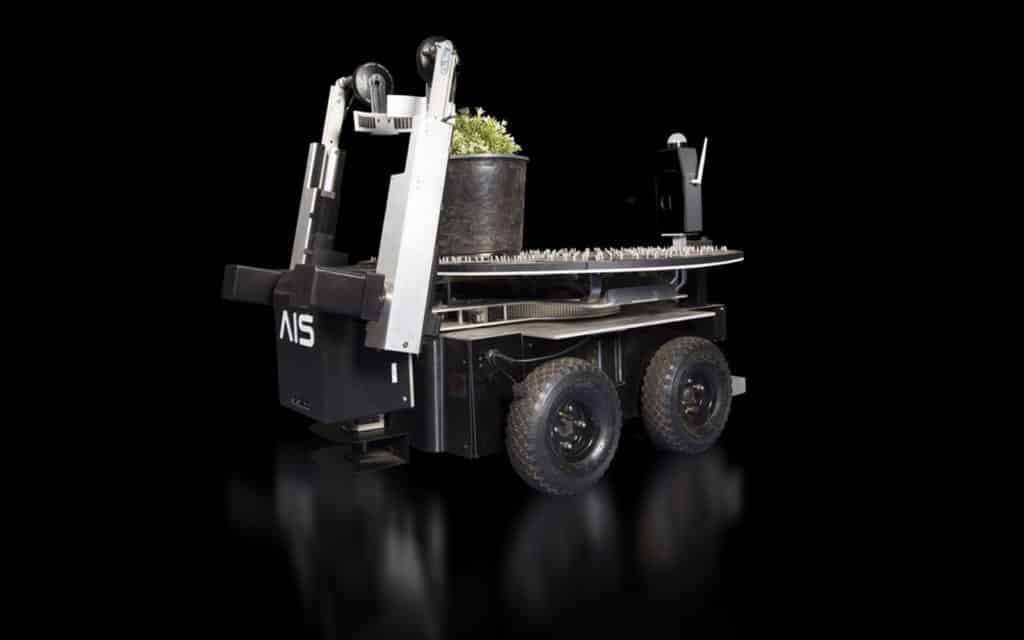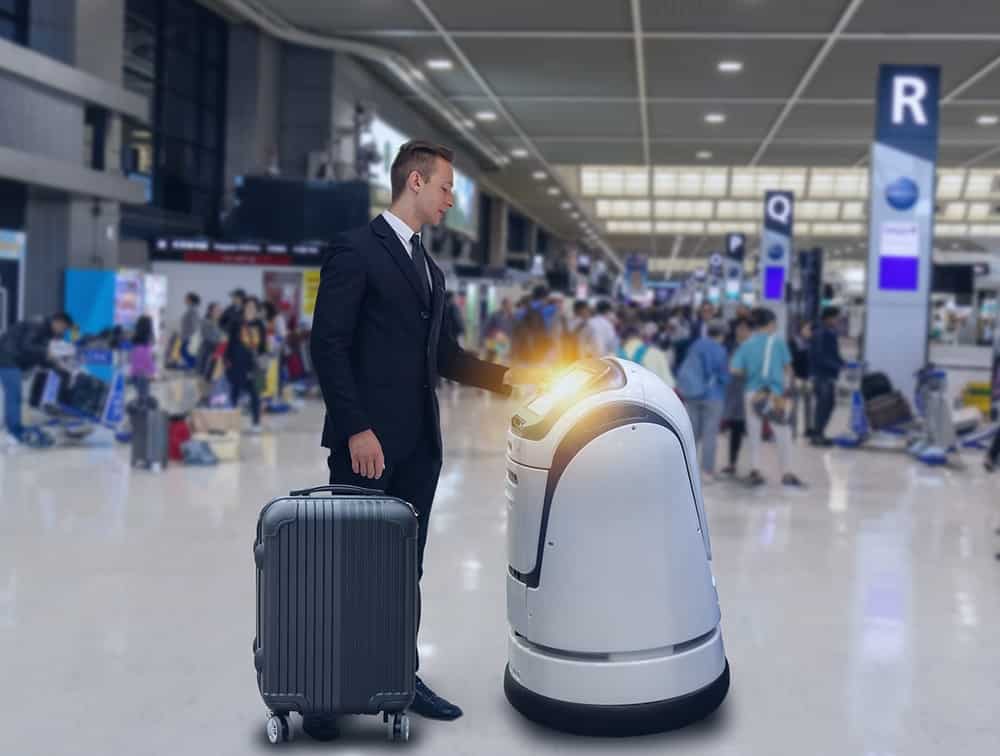Robotic Lawnmowers Reaping Billions of Dollars
Table of contents

The average American spends about 70 hours per year on lawn care and maintenance. For some, it’s a labor of love. For others, it’s time better spent watching football on Sunday. What’s an armchair quarterback to do?
The billion-dollar answer? Buy a robotic lawnmower like the one pictured below:
We’ve briefly discussed the subject of robotic lawnmowers on a couple of occasions, most recently during an in-depth look at iRobot’s market dominance in robotic vacuum cleaners. Now we want to dig a little deeper into the robotic lawnmower market itself. How niche is the market? And who are the players to watch?
Another way to put the first question: Is there any money to be made in robotic lawnmowers? The short answer: Between $2 and $4.6 billion, depending on who is doing the counting.
Beige Market Intelligence, in its “Worldwide Robotic Lawn Mower” market research report published earlier this year, projected the market would hit $2 billion by 2021, with a compound annual growth rate of 4 percent between 2016 and 2021. Europe accounted for the largest market share of more than 60 percent in 2015, according to Beige Market Intelligence. That’s particularly interesting since Europe accounts for only about 20 percent of the $38 billion global lawn mower market, versus the United States, with about two-thirds of the market share at $25.2 billion.
The second number of $4.6 billion comes from iRobot (IRBT), which appears poised to add robotic lawnmowers to its portfolio of autonomous home cleaning and care bots.

We’ve wondered previously if perhaps iRobot will stand up its own robotic lawnmower or look to make an acquisition among the contenders currently in the market. There are at least a couple of clues that suggest such a machine would be developed in-house. Robotics Trends reported earlier this year that iRobot had filed a trademark in 2014 for “Terra”, which was to be used for “robotic lawnmowers; structural and replacement parts and fittings for robotic lawnmowers.” Last year, iRobot received approval from the FCC to use wireless technology in tandem with a robotic lawnmower. Most robotic lawnmower systems require the user to set up a perimeter fence to help guide the machine. Maybe the extra labor – plus hefty retail price tags – is among the reasons why robotic lawnmowers aren’t getting much traction in the United States yet?
The idea that iRobot might buy its way into robotic lawnmower market seems less likely given the contender list. Most of the companies working in this niche are probably as big, if not bigger, than iRobot, though perhaps one might be looking to spin off a division to devote more attention to its core business. According to Beige Market Intelligence, the major players in the market include Husqvarna, Robomow, Zucchetti Centro Sistemi, Global Garden Products and Robert Bosch. Other prominent vendors in the market include AL-KO, Belrobotics, Deere & Co., E. ZICOM, Honda, Hangzhou Favor Robot Technology, MTD Products, Positec Tool, and STIHL.
Let’s take a closer look at the top five in this sector.
Husqvarna
Husqvarna is a Swedish-based company that is credited with rolling out the first commercial robotic lawnmower in 1995, Husqvarna produces outdoor power products for garden, park and forest care, including chainsaws, trimmers, riding lawn mowers and, of course, robotic lawnmowers. In September, Husqvarna announced that the robotic lawnmower market was profitable enough that it would increase manufacturing capacity for its Newton Aycliffe factory in England. At the same time, the company also said it will expand and build up capacity at its existing Husqvarna Group site in Vrbno, Czech Republic, by 2018. The company said that “due to the strategic importance of this product, we see the need to manufacture robotic mowers in more than one site to meet the growing market and limit the risk with only one factory.” There are also plans to introduce robotic mowers for its McCulloch consumer brand next year. It already sells robotic lawnmowers under its Husqvarna and Gardena brands.
In the company’s 2015 annual report, it said increases of net sales of 6 percent in its Husqvarna division and 8 percent in Gardena were driven largely from robotic lawnmowers sales in Europe. That trend seemed to continue into 2016. In an interim report published last month, the company said its Husqvarna Division “generated an increase in sales mainly driven by product leadership areas, especially in robotic mowers, which contributed to earnings growth as a result of favorable mix.”
The main innovation Husqvarna introduced this year was the Gardena Smart System, which launched in selected markets. The system connects water control systems and robotic mowers with sensors in the garden, allowing the user to monitor and operate the system via a smartphone or tablet, bringing the Internet of Things to the garden.
Robomow
Officially called Friendly Machines, Robomow comes from much humbler beginnings than Husqvarna. It was founded by two Israeli entrepreneurs, Udi Peless and Shai Abramson, in 1995. According to company lore, Peless’s wife asked him to mow the lawn on a hot summer day. Peless fantasized about shirking the unwanted labor by using a robotic lawnmower. Friendly Machines was born in 1995, apparently a seminal year for robotic lawnmowers.
Last year, the company saw U.S. sales rise 50 percent, suggesting that robotic lawnmowers may finally be making inroads in a market that has mostly been focused in Europe, where the cost of lawn care and maintenance is generally higher than in the United States. Will President-elect Trump’s border wall with Mexico make the $1,000-plus price tags of most robotic lawnmowers more competitive? Only time (and many, many miles of brick and mortar) will tell.
Zucchetti Centro Sistemi
Zucchetti Centro Sistemi, based in Italy, started in 1985 as a software company and eventually added automation and robotics to its growing portfolio. In 2000, ZCS becomes part of the Zucchetti Spa holding company, a leading software manufacturer in Italy with 3,000 employees. That was the same year ZCS began designing, manufacturing and distributing innovative hi-tech robots, including what it considers its“crowning glory,” Ambrogio, a robotic lawnmower line that has grown to include 17 models. Other robots in the company production line include feeding bots for dogs and horses, as well as a pool-cleaning robot.
One interesting offshoot to the robotic lawnmower category from ZCS is Agribot. As one might expect from the vino-loving Italians, Agribot is a robotic lawnmower specifically designed for clearing the grass between rows of grapevines at a winery. It looks a bit like a stripped-down golf cart. Cameras and other sensors help the robot recognize the rows of vines and cut only the grass between the rows. Not only that, but the whole contraption is solar powered. To that, we say, “salut.”
Global Garden Products
Another contender from Europe, Global Garden Products was founded in 2000 after four European lawnmower businesses merged: Stiga, Alpina, Mountfield, and Castelgarden. In 2011, Atco also joined the group. GGP sells more than one million products per year and sales are valued at about 480 million euros, with manufacturing spread across Italy, Slovakia, and China. It employs about 1,550 people worldwide.
The company has been making significant moves over the last several years to strengthen its presence in robotic lawnmower business, beginning in 2012 when it bought its way into the market with the acquisition ofLiCosrl’s Lizard robotic lawnmower brand. It now sells those mowers under its Stiga brand. At the same time, GGP joined forces with ZCS (apparently for dominance of the alphabet). In exchange for ZCS’s expertise in robotics research and development, GGP offered its marketing and sales network. In 2014, GGP claimed that one in almost every 40 lawn mowers is now a robot, with expectations of double-digit sales growth moving forward.
Bosch GmbH
Notice a geographic trend? Four of the five key players in this market are based in Europe. Robert Bosch GmbH is a German behemoth, with revenue of more than €70 billion in 2015. Its reputation has been built as an engineering and electronics company that supplies automotive components, but it obviously dabbles in a number of other markets, including household appliances, power tools, security systems, and thermal technology.
And, of course, robotic lawnmowers. It launched the Bosch Indegoin 2013, claiming it is the only robotic lawnmower on the market to cut in parallel lines. Once again a robot shows up a human. But can it open beer bottles with its teeth?
Probably not, but the Bosch Power Tools division took a big bite out of the garden tools market last year, with record sales of 294 million euros, corresponding to 6 percent growth. The company said new garden tools such as robotic lawnmowers and intelligent cordless tools generated about 40 percent of its sales. Bosch Power Tools appears to be most comfortable operating in Europe, with the Old World accounting for more than 90 percent of sales.
Conclusion
There is obviously faith in the future of robotic lawnmowers, based on the investments and interests in companies within and outside the current market. No doubt retail prices will start to drop as competition and demand heats up. And the right price point will be a tipping point for consumers to add a lawnmower to their private army of home maintenance robots.
Sign up to our newsletter to get more of our great research delivered straight to your inbox!
Nanalyze Weekly includes useful insights written by our team of underpaid MBAs, research on new disruptive technology stocks flying under the radar, and summaries of our recent research. Always 100% free.























It’s weird to see that robot vacums are more popular than robomowers. They get the exact same result as any other normal vacum would, whereas robomowers actually have been shown to improve the look of your garden.
I think this is really strange but if you say they are growing in popularity then maybe they’ll begin to take over – probably when they get cheaper!
I had an original Weed Eater (Husqvarna) brand robotic lawnmower in 1995. That unit was total solar power. I have been surprised it has taken this long for this category to expand. I believe it is still due to pricing and the novelty of the units. Once the USA is convinced this is not a flash in the pan gimmick, this will grow exponentially in North America.
Agree. There are some technical difficulties though when it comes to things like mowing around sprinkler heads, mowing over rocks, edging, and all the other things that landscapers do which a robot might find difficult. Perhaps lawn cutting services will begin employing these robots to save on labor costs.